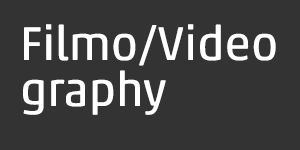Personal
Attention: Light! Józef Robakowski's light-based films and videos, Łukasz Ronduda
"I love to go to the movies. What I hate are the images on the screen."
Theodor Adomo (1966)
Józef Robakowski has been creating iconoclastic, non-representational
films with light as their "chief protagonist" as long as he has been artistically
active. As early as 1963, within the Torun-based creative group "Petia"
("Noose"), he created "Jezioro tabedzie" ("Swan Lake"). Filmed in a completely
darkened interior, the work involved Robakowski and his colleague Juliusz
Wendland performing an expressive dance to music from Tchaikovsky's famed
ballet while holding hoses from which issued gas flames - a smaller one
denoting woman, a larger flame denoting man. The "play of light" in darkness
is all that can be seen in the resulting film, which in itself is an interesting
reference to Polish abstract experimental film of the 1950s, particularly
to the films of Andrzej Pawłowski, whose creative strategy seems a significant point of reference for Robakowski. During the late 1950s, Pawłowski performed light shows he referred to as "Kineforms." The artist built a box-like projection device with classical optics and a reflector as its light source. Inside were two supports for variously colored transparent foils, which the artist manipulated to produce organic shapes on screen that moved to music. In 1957 Pawłowski produced a filmed version of "Kineforms" that was shown to great acclaim at art festivals in Madrid and Brussels in 1957-1958. Robakowski perceived as important both the "Kineforms" and Pawłowski's concept for his light-based works, a concept that defined the realm of art as an "energy field."
Pawłowski wrote: "Creativity is the pleasure of producing a kind of energy,
storing and emanating it (...) Energy conforms with accepted notions of 'artwork,' the primary task of which is to transmit energy." According to Pawłowski, a viewer inspired by this "energy transmission" might turn into a co-creator and intensify the transmission by producing his own energy field. In treating light as a conduit for pure energy, Józef Robakowski's light-based films, and in particular his video works, seem to develop on this dialogue of energies.
By the 1970s Robakowski was an active member of the Workshop of Film
Form and at this time created two radical, non-camera films in which light was the protagonist. "Test" (1971) and "Próba II" ("An Attempt," 1971) grew
out of inspiration (strong within the Workshop of Film Form) from the traditions of Polish and Russian Constructivism of the 1920s and 30s. Around this time Robakowski frequently cited the writings of Wtadystaw Strzemiński and Casimir Malevich, their concept of an autonomous art that would reject all references to what lay beyond the artistic realm. Malevich advocated art that would be exclusively iconoclastic, reject the "representation of material reality." In the spirit of Plato, he believed that representational art did not reproduce being (which is invisible to the eye), but solely its semblance (visible reality). Art was supposed to express pure, non-utilitarian feeling, desire apart
from all practical reality; for feelings of this nature provide access to "being
as such" - the absolute which Malevich termed "the pan-energetic universe."
Robakowski's light-based works seem to reconcile Malevich's radical "energetic" iconoclasm with Strzemiński's chief hypothesis regarding the reduction of the artwork to its elemental (basic) media determinants.
"Test" (1971) is precisely this kind of film as (in the spirit of Strzemiński)
it analyzes the cinematic medium - revealing it to be a "light-based"
communication - and initiates a singular "physiological and energetic dialogue"
between the work and its beholder (in the spirit of Pawłowski and Malevich).
Robakowski created the film without a camera, by producing several dozen
holes of various sizes in non-transparent film stock. When shown, the film
physically "leaks" the strong light of the projection lamp, "attacking"
the viewer, almost "burning itself" on the retina of the eye.
Through this "flickering" film that generates after-images, the artist effectively tests the physiology of the film viewing process. "Test" also delineates a series of material relations by "revealing" the projector's stream of "clean, white light" and underlining the nature of film as a mere "physical object in the projector." Beginning in 1973 (with the "Workshop Project" of the Museum of Art in Łódź), during screenings of the film Robakowski would stand in front of the audience holding a mirror and reflecting the "projected light stream" (leaked by the holes in the film) towards viewers. During one such performance at the Knokke-Heist Festival in 1974, this turned into a real "light battle" when the audience responded to Robakowski's "attack" with shots from their camera flashes. This best demonstrates the dialogic nature of Robakowski's film, its structural intent to activate viewers, provoke them to react, initiate physiological and energy transmissions between the work and its audience.
In "Próba II" ("An Attempt II") Robakowski explores the relations between
visuals (an intense red) and sound (classical organ music) in film. The artist has separated these two layers and presents them alternately, never giving viewers the satisfaction deriving customarily from synchronous reception.
The work is based on the concept of counterpoint and its "main topic" seems
to be the energizing power of sudden appearances of bright (red) light.
It is noteworthy that Robakowski's iconoclastic, non-camera films seem
to fully embody Greenberg's theory of "media purity." Among the projects
of the Workshop of Film Form, they also transcend most radically
the representation, illusion and narration inherent to traditional film utterances.
By the 1990s Robakowski was using video to produce many other works
employing light. "Impulsatory" ("Impulsators"), in which the artist reflects
on the nature of the video medium, seems the most revolutionary of these.
The work is an examination of the role of light in the medium. Designed
for presentation on a monitor, it consists of a series of (quasi stroboscopic) light pulses whose "flashing" underlines the phenomenon of emission,
i.e. the media-derived conditions of reception of monitor images. The "tingling
white light" reveals the TV monitor to be a "light (emitting) canon," a lamp
that radiates its content on to the viewer's body effectively rendering it
the screen upon which an image is projected (contrary to cinematic projection,
which sends images onto a screen over viewers' heads). The artist underlines
that the body of a viewer watching (or being watched by) a television
is effectively a screen for the television projection and is constantly attacked
by vast numbers of subconscious stimuli. This is a circumstance specific
to the medium of television, one often used by creators of advertising
who introduce image vibration or pulsating effects that speak more to our
bodies (compelling us to watch the events on screen unfold) than to that part
of our minds responsible for conscious decisions. In "Impulsators" Robakowski
thus unmasks a potential field of manipulation.
Addressed as it is to viewers' bodies, "Impulsators" manifests a strong
energetic-erotic aspect. Like "Test," it establishes a singular erotic link
between the "corporality of the medium" and the "viewer's corporality."
These two "bodies" engage in dialogue, involve one another. The resulting process (described by Anne Michelsson) involves the transfer of on-screen "cinematic desire," residing in the human body but focused in traditional cinema
on the filmed representation, to the "body" of the film (i.e. contemplation
of its materiality, physicah'ty). Robakowski intensifies this process through
a series of pulses, flickering and other light-and-sound attacks. When projected, these "film-bodies" and the bodies of viewers remain constantly, and almost sexually, linked. Read in this way, "Impulsators" reveals itself to be
a development not only on "Test," but also on the artist's "Zapisy Biologiczno-
mechaniczne" ("Biological Mechanical Recordings"), a creative project
Robakowski developed during the 1970s.
With "Video-pieśni" ("Video-songs") Robakowski seems to accept
the machine as an autonomous site in which the world is "perceived"
or representations thereof are created. "Video-songs" are a singular record
of the artist's struggle with a medium utilized in recording and distributing
images (in this case, video). Echoing his initial interest in light and film ("Swan
Lake"), Robakowski used a camera to record himself waving an illuminated
flashlight in a completely darkened room. He then technically manipulated
the images resulting from this "painting with light" (modifications of sound
are a very important part of the film), employing the very rudimentary "special
effects" achievable on his home VCR. Robakowski released the machine,
accepted its creativity. "Video-songs" results from friction between human
and non-human creativity, between acceptance of the machine's logic
and an effort to render that logic anthropomorphic, finally, between subjecting
the creation of an audio-visual representation to the control of human
imagination and accepting the possibility that images created by a machine
might transcend that imagination.
"1,2,3,4..." (1992) and "Kąty energetyczne" ("Energy Angles," 1994)
are attempts at transcending the previous iconoclastic projects through
the inclusion of representational elements. In "1,2,3,4...," which embodies
the artist's analytic stance, Robakowski softens his unwillingness to saturate
the work with his own subjectivity through subtle insertions of a representation of himself. The artist's image appears in short light bursts that last fractions of a second. The way light is used in the film evokes the process by which photographic representations are created, a process that involves subjecting photographic film to "lightning fast" exposures to reality. In "1,2,3,4..." Robakowski delineates the inter-medium relations between video
and photography, while in "Energy Angles" he tests the interdependencies
between film and video. The image is that of film stock running at a regular
rate, its perforations visible. A single line has been carved into the film along
its entire length, and a projector lamp shines through. These elements combine
to evoke a cinematic projection, and in general Robakowski's video works seem
to revisit "obsolete" media like photography and film. "Energy Angles" seems
to reach deeper into the past, recalling an even older "light-based communication" - stained glass. When light passes through the film stock in "Energy Angles," the film produces its spectacle as stained glass would - by withholding and modeling light. The line that runs the length of the film is an ironic reference to the linear narration of traditional cinema, a narration that constantly controls ("guides") the viewer's attention and perception.
Józef Robakowski (working with Wiesław Michalak) produced "Attention:
Light!" based on a film score by Paul Sharits. Sharits in turn based the film's
structure on strict synchronicity between music and visuals. On the one hand,
the film is the result of strict implementation of very rigorous constructivist
formal procedures that subordinate the melodic line of a musical piece
to specific visual values. On the other hand, the work is dominated wholly
by a nostalgic (Romantic) musical piece by Chopin. At first glance it seems
to differ from Robakowski's earlier films employing light, which prioritized
biological over symbolic contact, vitality and energy over representation
or depiction. I believe the contrary is true. Nostalgic music and Sharits' visual
structures characteristic allow us to view this as a kind of epitaph to Sharits,
created by Robakowski. The artist previously created a series of videos
and films titled "Epitafia" ("Epitaphs"), which were devoted to the memory
of deceased individuals ("Po człowieku" / "One Man Gone," "Rozmowa z matką" / "A Conversation with Mother"). These films were an attempt at preserving the energy of the deceased, energy that affects the present through memory.
Similarly, "Attention: Light!" attempts to establish an "energy-based dialogue"
with the oeuvre of a deceased artist, to revitalize his work. Robakowski thus
persists in his attempts to produce energetic friction between viewer and film,
between himself and the machines used in creating and distributing images.
In the case of the current project, Robakowski likewise understands artistic
communication to mean the transmission of energy embodied as light.







